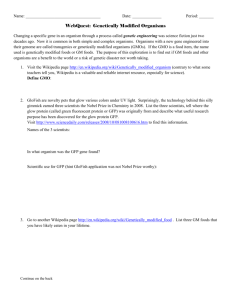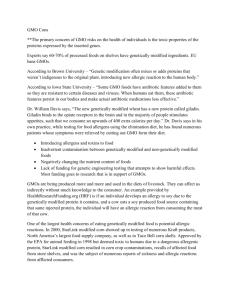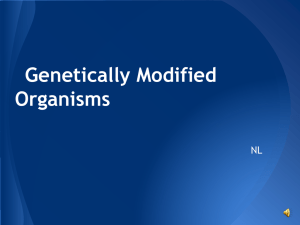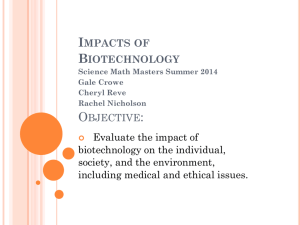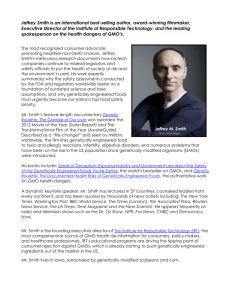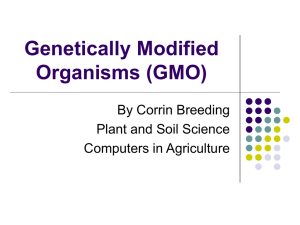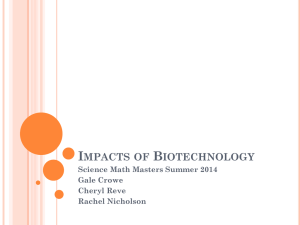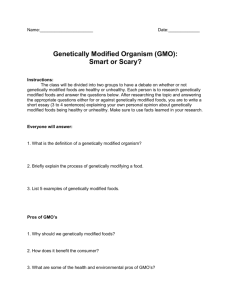Coauthored Paper on GMOs - Macaulay Honors College
advertisement
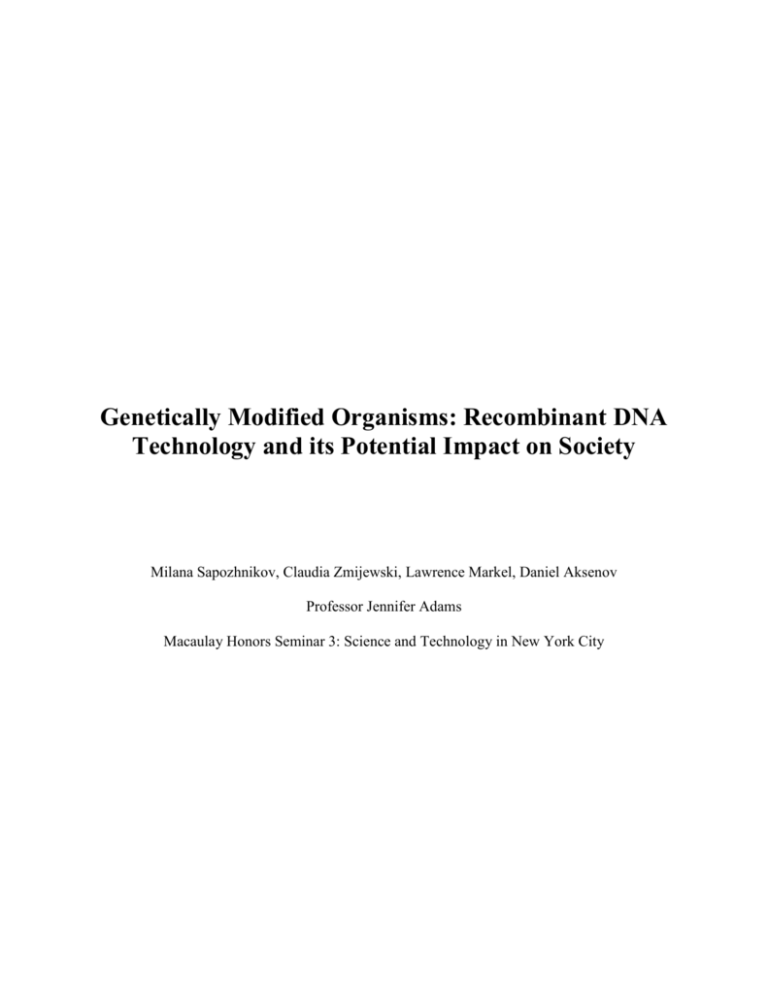
Genetically Modified Organisms: Recombinant DNA Technology and its Potential Impact on Society Milana Sapozhnikov, Claudia Zmijewski, Lawrence Markel, Daniel Aksenov Professor Jennifer Adams Macaulay Honors Seminar 3: Science and Technology in New York City Abstract: The purpose of our Citizen Science project was to teach high school students the basic facts about genetically modified organisms so that they could take a stance, or at least consider a side, on the GMO debate. The learning strands that were addressed in our Citizen Science project were Strands 1, 2, and 3—sparking interest and excitement, understanding scientific content and knowledge, and engaging in scientific reasoning. Although we included a substantial amount of scientific background on genetically modified organisms, the main focus of our project was the controversial GMO debate. Our final digital deliverable was in the form of a documentary, which was split between the hard science behind what genetically modified organisms are as well as how they are made and the pros and cons of GMOs. Our Citizen Science project was ultimately successful because we were able to have a productive discussion on whether or not GMOs should be considered a serious threat or a viable solution. Introduction: Genetic engineering is a dynamic field of biotechnology in which DNA is transferred from one organism to another organism to produce a genetically modified organism (GMO). These genetically modified organisms contain recombinant DNA, which is foreign DNA that has been incorporated into their own genetic information, and they are therefore termed transgenic. The field of genetic engineering has been rapidly growing because of the extensive uses for GMOs in our everyday lives. Genetically modified organisms are used primarily in agriculture to improve pest resistance, herbicide tolerance, disease resistance, cold tolerance, drought/salinity tolerance, and improve nutrition in food crops. Animals have also been genetically engineered to increase their yield and increase their disease tolerance. Salmon is an example of a commonly genetically modified organism engineered to enhance their size and speed up their process of maturity. Cattle have also been genetically engineered to promote their resistance to mad cow disease. But many ethical questions are also raised with the creation of genetically modified organisms. Potential environmental hazards such as unintended harm to other organisms, reduced effectiveness of certain pesticides, and accidental gene transfer to non-target species must be taken into account in the debate. Possible human health risks such as allergenicity and unknown implications need to be considered as well. As the field of genetic engineering has been expanding, it is essential to be aware of the implications and advantages of creating these organisms. As the public becomes more aware of the issue, they will better be able to formulate decisions what products to purchase and consume. Labeling of genetically modified foods has come into major question in politics, as the debate as to whether it is necessary to label these genetically altered foods should be required by law intensifies. Learning the science behind gene technology can provide insight into the ethics of the debate, and provide important knowledge about this growing field. Materials and Methods: The process of creating a genetically modified organism involves three main components: a gene of interest, a target species, a vector, and restriction enzymes. A gene of interest is a DNA sequence that contains the piece of genetic information desired for insertion. A target species is the organism that this piece of foreign DNA is inserted into. A vector is a way of carrying the gene of interest into the target species. A common vector that is used in biotechnology is a plasmid, which is a small extra chromosome of DNA that is found in bacteria. Restriction enzymes help in cutting out the gene of interest to isolate it from the original organism and incorporate it into the vector. Restriction enzymes recognize specific DNA sequences and cut at these specific places, which are termed restriction sites. Genetic engineering relies on these enzymes to cut the DNA molecules consistently at these precise points. The same restriction enzyme is used to cut the gene of interest out of the original organism and is also used to cut open the plasmid into which the gene of interest is to be inserted. Using the same restriction enzyme, allows for the creation of the same restriction fragments because the restriction enzyme cuts between the same exact base pairs in all instances. Therefore the restriction fragments of the DNA from the plasmid and from the gene of interest can be later joined together. The most useful type of cleavage that restriction enzymes do is the creation of sticky ends, which are single-stranded ends that are formed by a staggered cut. The short extensions of these sticky ends can hydrogen bond with other complementary sticky ends that have been cut with the same restriction enzyme. This is what happens in genetic recombination as these ends are joined together by hydrogen bonds and then permanently connected together by the enzyme DNA ligase. The DNA ligase creates covalent bonds that close the sugar-phosphate DNA backbone that the restriction enzyme previously cut. This connects the genetic information from the two different sources and therefore the gene of interest is inserted into the plasmid vector. This vector is then incorporated into the target species. The process of inserting a vector into a target species is termed transformation for bacteria (or transduction if using a viral vector) and termed transfection for eukaryotes. Discussion: While biotechnology has been rapidly expanding, the controversy behind the creation of genetically modified organisms has been growing as well. Proponents of GMOs stress the potential gene technology has in ensuring an adequate food supply for the increasing population of the world. On the other hand, opponents of genetic engineering stress the ethical issues behind the technology. One advantage of GMOs is that they can be insecticide and herbicide resistant. Insects have been a major cause of crop losses in farming recently and many funds are allocated yearly for chemical pesticides to try to combat the issue. Most people do not wish to consume products that have been treated with pesticides despite the advantages posed from the reduction in crop loss due to the extermination of the parasitic insects, especially since these pesticides are potentially hazardous to the environment. Several foods are also genetically modified to be tolerant against herbicides, the chemicals that are used to exterminate weeds. Although herbicide resistance is a key advantage when it comes to agricultural management and production, some people are still hesitant to consume foods that have been treated with any type of chemical. The widespread acceptance of GMOs would negate the problems that arise from consuming pesticide treated food. Other advantages of GMOs include giving organisms more desirable traits, higher food quality/taste, and more food production. Organisms can be genetically engineered so that they display new and better traits; for example, farmers have selectively bred corn over thousands of years so that corn would have bigger kernels. Introducing a more desirable trait through the process of genetic engineering can be compared to selective breeding, except that genetic engineering directly changes an organism’s genome while selective breeding simply alters an organism’s expressed phenotype. But the ultimate outcome of both processes is the same. Recent research has also shown that genetically modified organisms taste better than their non-GMO counterparts, another potential benefit of introducing genetically modified organisms to the food market. GMOs have also been found to increase crop yield while still using the same amount of land, and in a world where the global population is expected to rise as high as 9 billion in the next few years, this could prove to be an extremely useful advantage. On the other side of the GMO debate are the ethical concerns. If certain GMO containing foods are meant to kill off pesticides, one can imagine what kind of health affects these pesticides can cause to humans when they digest the foods. Another ethical concern is this role of playing god with certain aspects of nature. If certain foods where not meant to grow in nature, why are modern technologies making crops grow in previously inhospitable environments. Allergies from these GMO-containing foods also play a huge concern and because no long term effects of GMO’s have been conclusive due to the relativeness newness of GMO-containing foods. Our final digital deliverable was in the form of a 10-minute documentary. We tried to make our documentary as interactive and fun as possible, so we began our video with a popular contemporary song (Can’t Hold Us by Macklemore and Ryan Lewis) as well as a few quick shots of GMO examples (apples, cows, golden rice, etc) that our intended audience might be familiar with. The purpose of the lively introduction was to entertain the audience and cater to the first learning strand—sparking interest and excitement. The next portion of our documentary focused on the basic science behind genetically modified organisms, such as the definition of a GMO, how GMOs are made, and a little bit of basic biology about the central dogma of biology (DNARNAprotein). This is where we wanted to incorporate the second learning strand, or understanding scientific content and knowledge. We tried to include the first learning strand again in the middle of our video so that we wouldn’t lose our audience’s attention, so we included a picture of a small kitty that was genetically engineered to glow in the dark through the modification methods that we had just showed in the video. Next, we further discussed the exact ways in which the genetic code for a specific desirable trait was taken out of the cells of one organism and physically inserted into the cells of another organism. Although we did use scientific vocabulary in our documentary, we tried to introduce each unfamiliar word along with its definition so that if a member of the general audience wasn’t familiar with high school biology they would still be able to understand how GMOs were made. For example, we compared restriction enzymes to scissors and also included a picture of a strand of DNA being cut by a pair of scissors. We also used words like “promoter,” “terminator,” and “plasmid,” but each time we used these words we made sure to define them in simple everyday terms. We were essentially taking our in class presentation that we showed to Mr. Evangelist’s Regents Chemistry class and making it a bit more explanatory so that anyone could understand the science behind the making of genetically modified organisms. We included a picture with every single step so that members of the audience could visualize each step as it was being described in the documentary. After the detailed step-by-step description of how genetically modified organisms are made at the molecular level, we again went back to the first learning strand so that the members of our intended audience wouldn’t lose interest in our documentary after being exposed to a significant amount of scientific information. However, this time we showed a picture of Glofish, a type of pet fish that can glow in the dark in six different colors. We thought the picture of the Glofish would be perfect to show right after the big block of scientific content because it would ease the atmosphere. We didn’t want our audience to get bored after watching a big portion of the documentary that was strictly focused on science learning. The second half of our documentary introduced the pros and cons of genetically modified organisms. This is where the third learning strand came in—engaging in scientific reasoning. We wanted our intended audience to take in what they had just learned about genetically modified organisms and consider it when thinking about the good side and the bad side of the GMO debate. The documentary showed that the pros of genetically modified organisms included resistance against disease, resistant against insects, resistance against herbicides, more desirable traits, higher food quality/taste, and higher food production. It also showed that the cons of GMOs included the loss of biodiversity, health risks and allergies, as well as the contamination of other organisms. The next portion of the second half of our GMO documentary shifted to the video we took of our presentation at Brooklyn Technical High School in Mr. Evangelist’s Regents Chemistry class. We recorded a total of 15 minutes when we were presenting to the sophomores, but we only incorporated about 5 minutes of video into our final documentary. The 5 minutes that we included were of us talking about the pros and cons of GMOs, with Milana leading the discussion. We were careful not to take any specific stand on the GMO debate so that our audience of sophomores could make their own educated decisions and take a stance on the controversial debate. Results: Our citizen science project was held at Brooklyn Technical High School in a Regents Chemistry class. We decided to bring our PowerPoint and documentary to a class filled with students that understood the field of GMO and biomedical engineering to a degree so it would be easier to explain the more difficult points of bioengineering that perhaps the general public would not easily understand at first. Our old high school science teacher, Mr. Evangelist, let us take over his class for 15 minutes so that we could present to the classroom and also gave considerable amounts of insight and information during the class discussion about the pros and cons of GMO’s in foods and animals. They seemed interested from the beginning that there was a group of college students who had previously attended the high school coming back to teach something learned from college. In the first few slides of our presentation the first learning strand was used to spark interest by including a catchy song during the slideshow and by using a glow in the dark cat and mentioning that GMO’s can make this happen. The students seem to enjoy that fact particularly and began to open their eyes more to the information that was to come. We started off with the mechanism on how to derive a genetically modified organism from DNA and how the process of inserting desirable genes into DNA results in a desirable trait being expressed once DNA replication and translation occurs. Then we broke down the negatives and the positives of GMO’s and the classroom began taking sides and students started contributing their own thoughts and opinions. We asked them some possible negative consequences of GMO’s in the agricultural world and one student brilliantly argued that if GMO’s in corn, for example, offer pesticide resistance and kill off the bugs that try to eat the crop, wouldn’t it be harmful for humans to eat the corn as well. This is a very legitimate concern in the field of GMO’s because the long-term effects are unknown due to this relatively new biotechnological process. However, we also had comments that ranged into the positive aspect of GMOs such as possibly ending world hunger because of the ability of genetically modified crops to grow in conditions that are virtually inhospitable to organically or naturally growing crops. Another positive effect of GMO’s that was mentioned by another classmate was the fact that nutritional malnutrition is a serious problem in developing countries and more often than not, nutritionally rich foods are not available to these communities in adequate quantities. What current bioengineering technology has allowed us to do is enrich vitamins and minerals to certain foods such as rice in order to alleviate the nutritional deficiencies in the rice. After looking more into the student’s classmate, our group found out that scientists at the Swiss Federal Institute of Technology Institution for Plant Science have created a strain of “golden” rice that contains very high vitamin A content. We were surprised to see so many people with their own formulated opinions of the topic before we started to get into the pros and cons that we listed out to present to the class after the discussion. We did not think that high school students would be so interested in science, especially when they are exposed to science every day in school. We were proud with the discussion and the feedback was excellent. Mr. Evangelist emailed us the day after and told us that after we left, the class still kept talking about GMO’s and that a even bigger discussion broke out. That is very pleasing to hear because it means that we not only taught them something but that we sparked interest effectively. Our goals to offer an unbiased lecture on genetically modified organism were completed beyond expectations. Even we learned some new and interesting facts from the teacher and from the students. Our presentation in the Macaulay building will hopefully captivate all the listeners and spark an even bigger discussion. Let’s go, GMO! Conclusion: Our final project presentation was a success. Each member of our group was able to educate themselves about genetically modified organisms, how they are made, and how they affect us, as well as use this new information to teach others about genetically modified organisms. We were able to maintain an unbiased stance on GMOs, so that our intended audience could make their own informed decision about genetically modified organisms based on the information they learned from our presentation.
